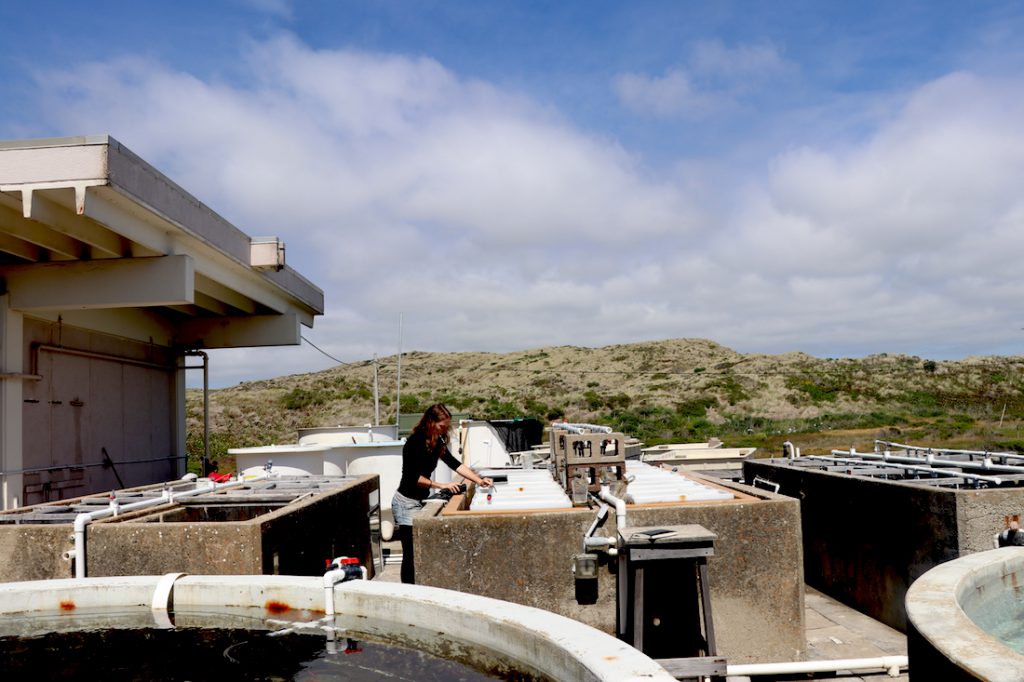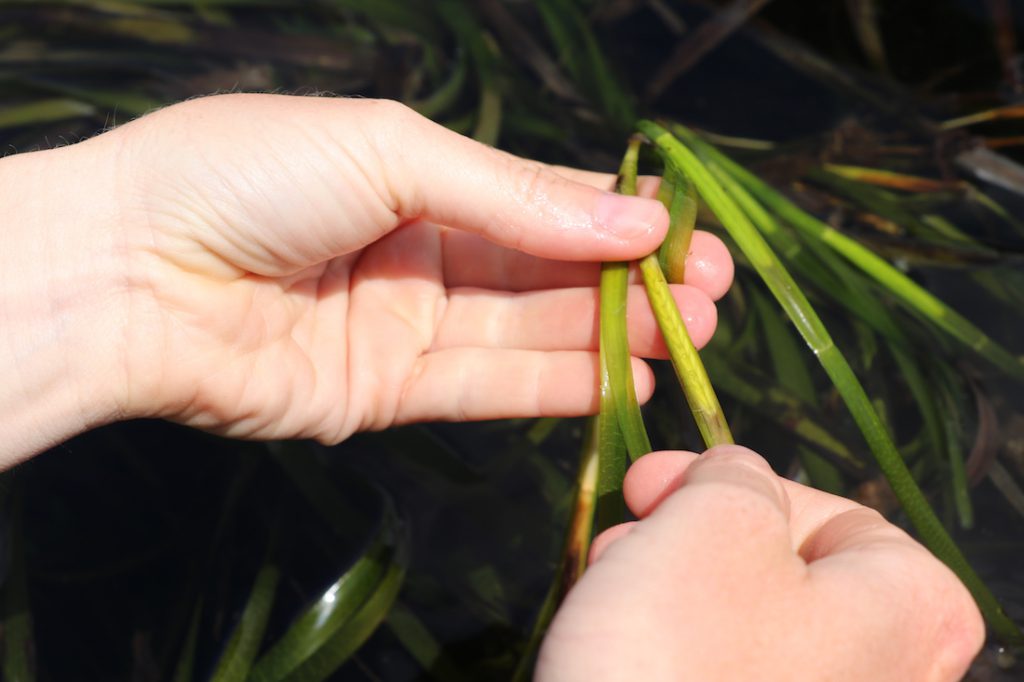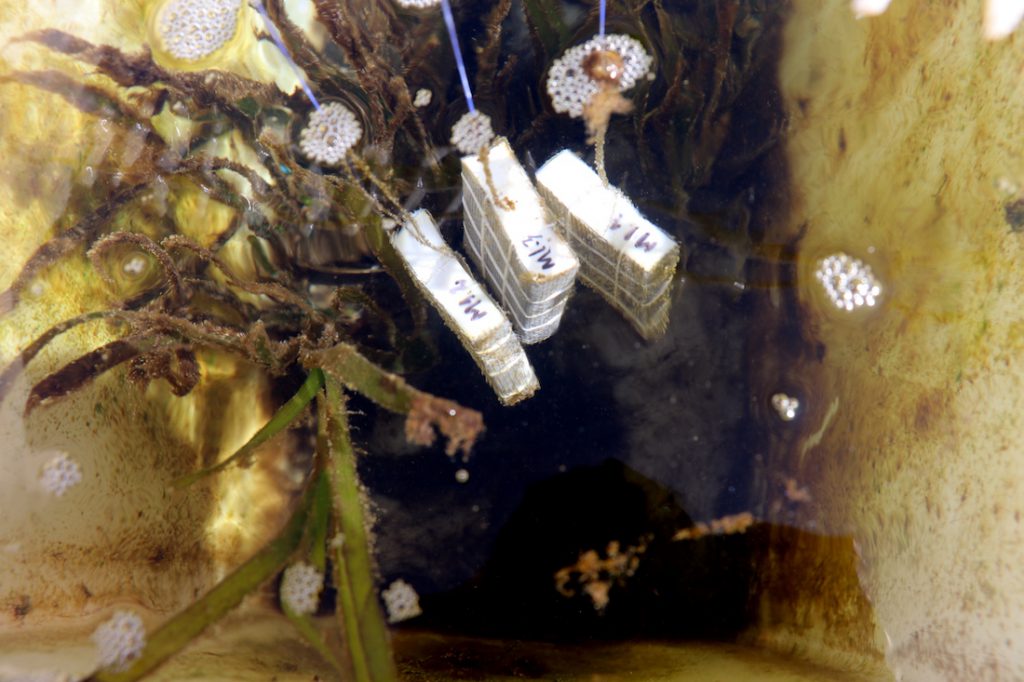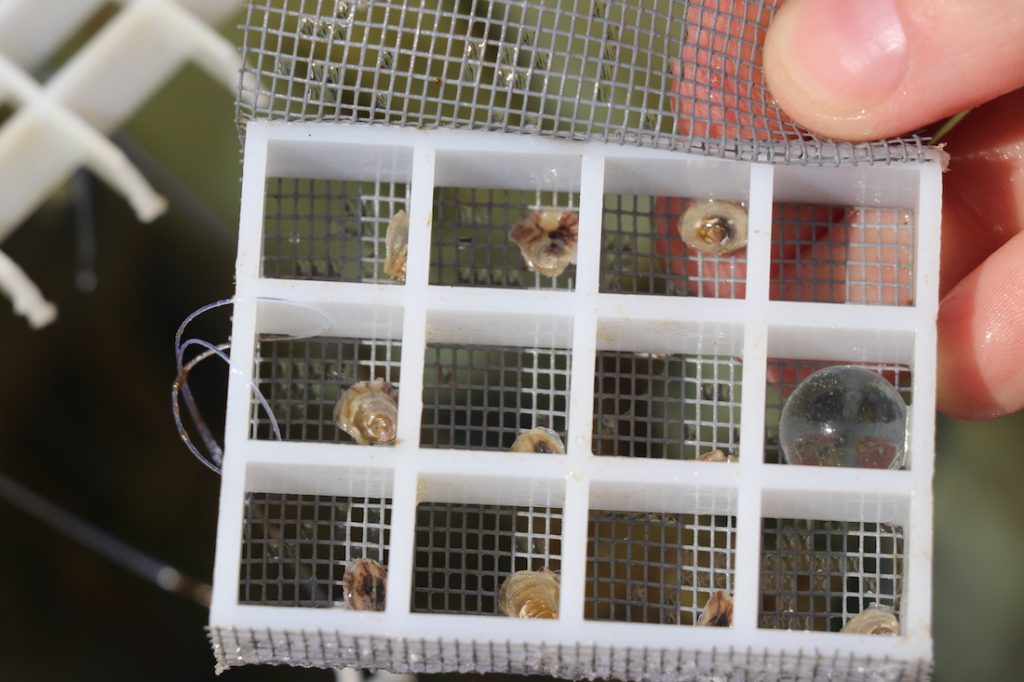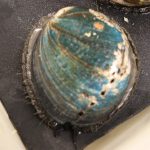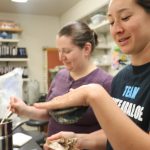This is the second is a series about Medill News Service reporter Rebecca Fanning’s embedded reporting experience at UC Davis’ Bodega Marine Lab in Bodega Bay, California. Read the original post here.
By Rebecca Fanning
Endangered black abalone receive an aromatic spa treatment while hundreds of baby oysters float in tiny cages next to winding strands of seagrass, their growth tracked and measured by resident ecologists.
In the world of shelled invertebrates, researchers handle their subjects carefully, especially the babies who are hypersensitive to change and tend to die quickly and without warning, a habit that make them more difficult to study than their more resilient parents.
As these shelled creatures grow, researchers measure their shells, record water chemistry, and take pictures, searching for clues and patterns that will help resolve mysteries about the health of shells and changing ocean environments.
What do these marine invertebrates need to survive in changing ocean conditions? And what is the role of science in rebounding or preparing their populations for the future?
I caught up with Bodega Marine lab ecologists, research scientists and technicians to learn more.
AURORA

Ph.D. ecologist Aurora Ricart works closely with the Bodega Ocean Acidification Research Group (BOAR), to gather data to answer this question: Does the presence of seagrass reduce or increase the pH level of the water where it grows? And if so, how does this affect the growth of calcifiers, shellfish that use carbonate and calcium ions dissolved in seawater to build strong shells and skeletons?
This question has been debated for years, and marine ecologists have opinions on both sides. But there’s not yet enough data to prove or disprove the power of the plant. That’s what Ricart is hoping to do. And she’s using oysters as her test species.
“I’m very happy to be on the project to try to gain some of this data. The goal of project is to have enough data to be able to give a powerful message, right now we have no evidence at all.” –Ricart
NATURE ON STEROIDS
There’s algae everywhere—coating the green seagrass, hanging off of tiny oyster cages and coating the insides of the glass tanks. For Ricart, the productivity of northern California’s marine ecosystem presents new challenges for her research.
A native of Valencia, Spain, Ricart earned her Ph.D. in ecology from the University of Barcelona where she focused on seagrass in the more “oligotrophic,” or nutrient-limited environment of the Mediterranean Sea. While Ricart has never worked in an environment such as the Pacific Ocean before, her seagrass expertise makes her an ideal person for the job. But this algae is an unexpected annoyance in her experiment, one she hasn’t encountered before.
“That’s why I have all of this algae growing, I’m like, ah, what am I going to do with all of you? The productivity you can get around here, it’s crazy,” she says.
“That’s why I have all of this algae growing, I’m like, ah. What am I going to do with all of you? The productivity you can get around here, it’s crazy.”
That productivity is one thing that attracted Ricart to the Bodega Marine Lab for a postdoctoral position in Tessa Hill’s lab. The waters off of Bodega Bay are part of the California Current, one of the most productive in the world thanks to annual upwelling events that bring cold, nutrient-dense water to the surface. That consistent flow of nutrients is to marine animals what protein powder is to a bodybuilder, a fast-track to major growth. So it’s unsurprising that Bodega Bay’s landscape can often feel like nature on steroids.
To deal with the explosion of algae, Ricart moves the seagrass plants into different tanks with “grazers,” tiny slugs who chomp on the algae and clean the plants. She keeps grazers out of her experiments because their respiration rates–the way they breathe–would impact the water’s pH and change her experiment.
A CHAIN REACTION
While the grazers chomp on green algae, baby oysters are hard at work. Once they leave the larval stage and begin to build their shells, they’re unable to move on their own. So the tiny creatures filter calcium out of ocean water and use it to build strong shells. Oysters and other shell-dwellers who grow this way are called calcifiers because of their reliance on calcium carbonate in the waters where they live.
The three-month-old oysters are barely larger than the head of a thumbtack and it will be two to three years until they’ll resemble the fist-sized adults we see on our plates.
But Ricart’s not raising these oysters to barbecue or squirt with lemon and horseradish for Bay Area weekenders. She’s raising them as part of an experiment to investigate how the amount of seagrass in water can change its chemical makeup and whether this change has an impact on the growth of shell-forming marine invertebrates like oysters.
“We chose oysters because we have a collaboration with Hog Island Oyster Farm, and because this is the main aquaculture product in the area,” she says. The body of research for oysters is also more extensive than other calcifiers because of their economic value as a salty delicacy, allowing the team to use past research to inform their work.
Ricart and her team know that different amounts of seagrass impact fluctuations of pH. In tanks with more seagrass, the pH varies more, while the tank with less or no seagrass experience less photosynthesis and hence have more consistent pH levels throughout the day or night. This is exactly what she expected.
“The first part of the experiment is working,” she says. “What we want to see now is the effect of the fluctuations on the oyster growth.”
SO WHAT IS OCEAN ACIDIFICATION? The ocean covers seventy percent of the earth’s surface. And as emissions from industry and cars send increasing amounts of CO2 into the atmosphere, it’s the oceans that absorb vast quantities of it,moderating global warming associated with climbing CO2 levels in the atmosphere but transforming the chemical makeup of the water. The measure of pH (potential of Hydrogen) spans a scale from 0 (very acidic) to 14 (very basic). Bleaches and drain cleaners clock in around 13 or 14 while lemon juice and battery acid measure at 1 and 0 respectively. Over the past 300 million years, ocean water has remained somewhat basic with a pH of 8.2. But since the industrial revolution and rising CO2 emissions, levels have dropped to 8.1. The ocean is acidifying 100 times faster than it has over the last 55 million years and models project that pH could dip as low as 7.75 by 2100, according to the European Environment Agency.
THE POWER OF A PLANT
In a climate of increasing coastal storms and water quality threats, seagrass ecosystems are an ecological powerhouse. They absorb carbon at an incredible rate, removing carbon dioxide from the atmosphere before joining the warming layer around our atmosphere, and they deposit that carbon into the sea floor, burying it in the sediment. They also provide a structural habitat for fish and other ocean dwellers, and act as storm surge buffers for beaches and coastal communities. So when you plant seagrass beds or preserve existing ones, you do a service for the Earth.
Like land plants, seagrass harnesses the power of the sun to grow through photosynthesis. And as it grows, it changes the chemistry of the water. But since the sun only shines during the day, and even then not every day, Ricart must evaluate the impact of day and night on the growth of her baby oysters.
Each morning Ricart arrives at the lab every before sunrise to measure the pH level at her tanks. Then when the sun is highest in the sky, she measures again. This way she’s able to see the impact of periods of extreme darkness and extreme sunlight on the water chemistry.
She has wanted to study the sea since high school and wanted to be a marine ecologist ever since she heard the term.
“For me, research is not just a job – it’s a way of life,” she says. “It’s being paid to follow your passion and to answer questions of common interest.”
She has wanted to study the sea since high school and wanted to be a marine ecologist ever since she heard the term.
So what is the potential of this common plant? Could the eelgrass that sways in the surf offer part of the solution to changing oceans? Or is the grass just as it looks, a simple plant with ordinary properties, itself in need of saving?
PART 2

SPA DAY IN SONOMA
The room smells like fresh beeswax with a hint of coconut. As research scientist Blythe Marshman warms the wax, stirring it occasionally, she prepares the working area. Brushes for coating, an area for the patients to sit, and a notebook to log them by name, keeping track of who was waxed and when.
“It’s important not to let it get too hot,” she says, giving the pot another stir.
“All of these ingredients are organic. We use organic, local honey and organic, fair trade coconut oil. I feel like the Sonoma County niche market would be very supportive of that.”
“All of these ingredients are organic,” junior specialist Malina Loeher adds. “We use organic, local honey and organic, fair trade coconut oil. I feel like the Sonoma County niche market would be very supportive of that.”
Marshman and Loeher don’t work at a day spa, though those are popular in Sonoma County. They work for the California Fish and Wildlife’s Shellfish Health Lab, an operation based at BML. Today they’re waxing endangered black abalone, a process that removes organisms from the marine snails’ ridged outer shell.
These organisms are all epibionts and endobionts. like polychaete worms, boring bivalves and sponges. These filter-feeding organisms “use and abuse” the abalone’s shell, zapping the animals of energy and fitness in a dangerous game that can lead to infections and death, especially in captivity.
Once the shells are free of these organisms, the abalone can often repair shell damage and dedicate more of its energy expenditures to growth and gonad development—both of which are incredibly important for broodstock in a successful captive breeding program.
VIP TREATMENT
The team will wax 12 of the blue-black adults, a process that involves carefully removing each from its happy home suctioned to the bottom of an underwater tank. An inability to clot blood means that the slightest knick of the animal’s “foot” with a knife could spell infection or death for the abalone. Though the Shellfish Health Lab recently completed a study that showed that abalone may be a bit more resilient to small cuts than previously thought.
While waxing is a common practice for abalone in captivity, the Shellfish Health team still approaches the process cautiously.
“Since abalone need to be removed from their tanks to be waxed, we also have to weigh the cost versus benefit to removing animals for treatment, as there is always the potential risk of injuring them or causing them to spontaneously spawn from stress,” Marshman says.
BML is home to 15 black abalone, most of which were collected from various locations throughout the Central California coast between 1995 and 2003 (prior to being listed as federally endangered in 2009). About a third of the abalone were provided by colleague, Carolyn Friedman, professor of aquatic and fisheries science at the University of Washington.
The team weighs each animal, check its reproductive organs for size before painting each shell with the organic mixture, carefully avoiding small gill-holes and the muscular “foot” of the animal. After a few minutes of drying they’re returned to their underwater homes, smelling slightly better than before and covered in a yellowy coat of wax.
PROTECTION & RESTORATION
Supervised by research scientist Jim Moore, The Shellfish Health Lab diagnoses and monitors diseases in wild and farmed shellfish throughout California.
The lab is also actively involved in the detection of invasive species and the rehabilitation of native abalone populations up and down the California coast. While lesser-known than the recreationally popular red abalone and less threatened than the critically endangered white abalone, black abalone populations face their own set of threats.
“The black abalone are my favorite,” Marshman says as she examines one with a slightly broken shell. “They are the only abalone species in California that lives solely in the intertidal zone, which means they need to be exceptionally hardy to deal with additional stressors that intertidal organisms face (e.g., desiccation, waves). I guess I have soft spot for animals that have to work harder than others merely to survive. Also, the exterior surface of the black abalone’s shells can range from black to a brilliant bright blue, which is a rare color to find in animals.”
Black abalone are prone to diseases and they live in the shallow waters of the intertidal zone from Baja California, Mexico, to Sonoma County, California. While their tough meat makes them less appetizing for diners, their location close to shore means they’re still prone to poaching like their red cousins.
Over the next month that wax will suffocate any organisms that may have taken up residence in the ridges of the shell, and when it begins to flake, Marshman and her team will use dental tools to chip the wax away, preventing bacteria from growing on top. This part doesn’t smell quite as good. The organisms that the wax has killed tend to give off a strong odor.
There are seven species of abalone that live along the California coast, a small number compared with the roughly 70 species that occupy intertidal and subtidal waters in nearly every continent.
“There’s just something about finding a black abalone in a deep rocky crevasse in the intertidal—kind of like finding a large nugget in a gold mine,” Marshman says. “It makes them one of the more unique abalone species in the world.”



